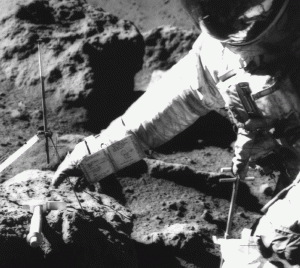Para os lunáticos
Será possível visitar a Lua sem sair da cadeira? Bom, hoje em dia, podemos dizer que sim, virtualmente. E uma das maneiras de o fazer é olhar para os visitantes lunares ao nosso planeta.
As missões Apollo trouxeram para a Terra mais de duas centenas de kg de amostras lunares, de diferentes tipos de rochas e de solos (ou melhor, rególito). Todas elas foram catalogadas e guardadas no Lunar Sample Laboratory Facility, que fica no Johnson Space Center, em Houston, Texas. Muitas ainda lá estão, intocadas, preservadas nos seus recipientes com atmosfera protectora, para evitar a deterioração que o ambiente terrestre, tão diferente daquele em que se formaram, lhes provocaria. Ainda assim, muitas foram estudadas, algumas retalhadas, reduzidas a fragmentos desbastados para produzir lâminas finas ou esmagados para análises químicas, distribuídas por laboratórios por todo o mundo. Algumas foram oferecidas às nações da Terra (e dessas, algumas, como a que foi oferecida a Portugal, foram roubadas…).
Existem inúmeros catálogos das amostras lunares. Quem quiser saber como foram estudadas e que informação deram, ou seja, ser apresentado ao nosso satélite natural – ou ao que sabemos dele – de uma forma rápida, pode consultar muita dessa informação aqui, por exemplo. Encontrará basaltos, brechas, rochas plutónicas, amostras de rególito… e muito mais, como este guia educacional da petrografia lunar.
E sim, há muitas perguntas ainda por responder. E muitas ainda por pôr, até. Razão mais do que suficiente para que (pelo menos) alguns andem na Lua. De martelo em punho. De novo.
Can we visit the Moon without leaving the chair? Well, in today’s world, we surely can say yes, if only in a virtual way. One of those ways is looking at lunar visitors to our planet.
The Apollo m issions brought to Earth more than two hundred kgs of lunar samples, including different types of rocks and soils (or rather, regolith). All of them were catalogued and kept at the Lunar Sample Laboratory Facility, located at the Johnson Space Center, in Houston, Texas. Most of them are still there, untouched, preserved in their boxes with protective atmosphere, to avoid deterioration in the terrestrial environment, so different from their place of origin. Nonetheless, many were studied, some cut up, reduced to fragments that were worn down to produce thin sections or crushed to conduct chemical analyses, distributed by laboratories the world over. Some were offered to the nations of Earth (and some of those, such as the one presented to Portugal, were stolen…).
issions brought to Earth more than two hundred kgs of lunar samples, including different types of rocks and soils (or rather, regolith). All of them were catalogued and kept at the Lunar Sample Laboratory Facility, located at the Johnson Space Center, in Houston, Texas. Most of them are still there, untouched, preserved in their boxes with protective atmosphere, to avoid deterioration in the terrestrial environment, so different from their place of origin. Nonetheless, many were studied, some cut up, reduced to fragments that were worn down to produce thin sections or crushed to conduct chemical analyses, distributed by laboratories the world over. Some were offered to the nations of Earth (and some of those, such as the one presented to Portugal, were stolen…).

There are several catalogues of lunar samples. Anyone who wants to know how they were studied, and what data they surrendered, in other words to become rapidly acquainted with our natural satellite – or what we know about it – can consult much of that information in here, for instance. Basalts, breccias, plutonic rocks, regolith samples will be waiting… and much more besides, such as this educational guide to lunar petrography.
And yes, there are still many questions unanswered. And many that need to be raised, even. Reason enough for (at least) some to walk on the Moon. Hammer in hand. Again.


Leave a Reply